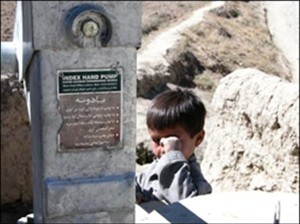
USAID provides communities with wells to improve health of rural villagers
1 DECEMBER 2003 | KULANGHAR, LOGAR PROVINCE
Challenge
Afghan parents face a harsh reality in child-rearing — an under-five mortality rate of 257 dead children per 1,000 living. Unclean drinking water contributes significantly to those harsh numbers. Severe cases of diarrheal disease were on the rise in Kabul in 2003, with an estimated 7,800 reported each week. Many rural villages turned to chlorination when available — but the chlorination campaign did not reach Kulanghar in the Logar district. In addition, many villagers reported that their shallow well levels fell between five and ten meters during the past year due to deep wells dug more than seventy meters into the earth. Deep wells harm the water table by taking the majority of the water and leaving it dry, usually to benefit only a precious few.
Initiative
In response to a water emergency which ensued after the Taliban’s fall in October 2001, one of USAID’s main priorities in Afghanistan was to increase safe, potable water. Such programs include the installation of forty community hand pump wells averaging 37 meters deep in three rural districts of Logar province.
USAID is working with local non-governmental organizations to identify rural areas in desperate need of drinking water. Community members volunteer to exchange their excavation labor for the well. Local partners provided the concrete pedestal, cover housing, stainless steel pump and piping, and instruction in both proper maintenance and use of the facilities.
Results
Today the forty pumps provide water to more than 200 families, or about five families per well. More than 80 percent of villagers who benefit from the wells indicate that drinking water is much cleaner from the wells than from their usual source, and 96 percent indicate that their drinking water source is now reliable.
The baselines for these results rose from zero; everyone who benefited from this project had once drank dirty water and had an unreliable source of drinking water. Incidents of dysentery and bacteria or organisms in the water dropped significantly since the wells were installed. Moreover, travel time between home and drinking water sources have plummeted since USAID completed construction in October 2003.







Comment
Make a general inquiry or suggest an improvement.